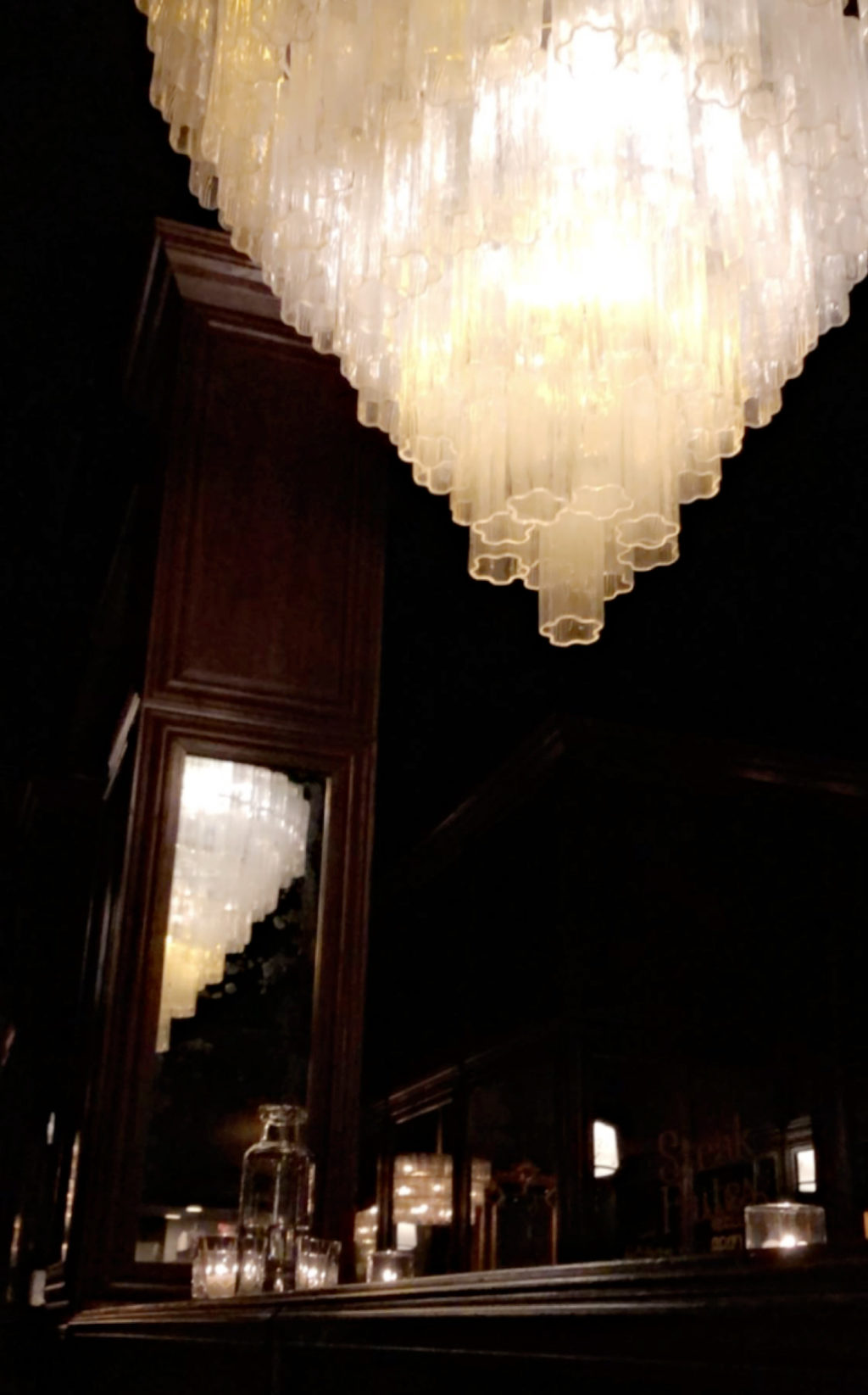Bavette’s Bar & Boeuf excels in Chicago’s crowded steakhouse sceneby consciously subverting so many of the nasty tropes that have plagued thisgenre of restaurants nationwide. There is little glitz and even less glamour.Rather, you walk into a wood-paneled, leather-lined, and candlelit sanctumwhere one need not concern themself with whatever their neighboring diners aredoing. The French inflection—alluded to in the restaurant’s name—isappropriately minor: the fries come with aioli, the steaks with béarnaise,there’s a Lyonnaise salad on offer, as well as a peppered duck and goat cheeseterrine. Otherwise, Bavette’s does not tether itself to any Francophilic theme,allowing it to ultimately channel an authentic feeling of “Old Chicago” thatrival establishments can only be said to bastardize.
You have been dining at Bavette’s for a little over three years now.The place hasn’t gotten much easier to get into, but it has undoubtedly strengthenedits offerings while never lapsing in the quality of its most signature items. Itis early November, and you spy the restaurant’s familiar red awning in theshadow of the Merchandise Mart. You reach the block, hop past two other Hogsaltproperties (Gilt Bar and the glistening new Ciccio Mio), and hurl open the doorjust a couple minutes before your reservation time. The vestibule in which thehost team stands can get a bit cramped, but they recognize you and cycle youthrough one more door with the invitation to grab a drink and come get themwhen the rest of your party arrives.

Usually, you resent not being seated immediately. Surely, therestaurant would rather you begin ordering and decanting a couple bottles ofwine right now than see this small window of time wasted on a triflingcocktail. Yet it is no matter, as you find Bavette’s ample waiting area quiteattractive. You sink into a plush easy chair staring across at an even softerlooking couch. The brick wall behind it boasts an arrangement of antiquepicture frames featuring unknown visages. Another would-be diner passes throughthe vestibule and takes a spot on the couch. In his haste to unburden himselfof his belongings, this old man let’s a bottle of wine fall flat against thetable. The sound is sickening, yet the glass survives (and you do your best tohide the grimace you have grown).
Truth be told, you regret not having brought a bottle along yourself.Bavette’s has always maintained the most generous, jovial “BYO” policy: sharehalf a glass with any other customer in the restaurant, and the $50 corkage feewould be waved. This, in a city where most steakhouses do not allow corkage atall, is a triumph. It tells you just what sort of establishment Bavette’s wantsto be. Though you have brought your share of Cult Cabs, Barolos, and decades’old Bordeaux through here over the past couple years, the restaurant’s own winelist has done wonders to satisfy you recently. While always approachable(predominantly offering domestic and French bottlings in the $50 – $150 range),the beverage selection has blossomed over the last year with top value offeringsfrom producers like Delamotte, Roulot, and Keller for less than $100. Thosewith a taste for red wine (read: everyone) will now find an expansive list ofmagnums along with “Rare & Mature” offerings that climb towards the$500-$1,000 range. While most diners will be more than happy with the list’smore humble selections, Bavette’s best wines on offer are well-curated andpriced well below what any other steakhouse would charge. Maple & Ash, forexample, would never carry such a stock of magnums in the $200 – $500 rangewhen they aim to squeeze winos for two or three times that. Simply put, thewine list at Bavette’s—like the corkage policy—rewards wine drinkers, welcomesthem, whets the appetite without digging the proverbial steak knife in too deepfor those special occasion diners.
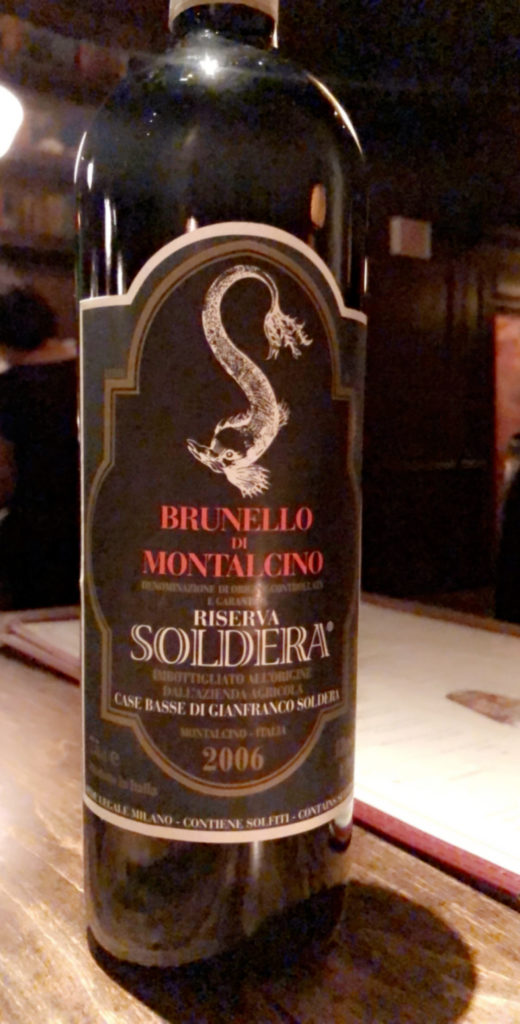
One of your favorite servers, Erik, spots you in the easy chair andoffers you (as well as the embarrassed man across from you) some water. Youtrouble him for the wine list too. Though customers could easily be forgotten,or ignored, while waiting for their tables, the staff—to their greatcredit—makes sure they are offered drinks. The list arrives, and you get lostin it. Many paths of vinous pleasure open up, but only one beckons. Erikreturns, unprompted, to tell you about the bottle one table tried on Tuesdaynight. As fate would have it, that bottle was the 750 mL size of the wine youwould like to get this evening in magnum. The server’s eyes light up—he fancieshimself somewhat of a sommelier, though Bavette’s does away with any of thatformality. Licking his lips, he reaches for the memory of the other bottle. “Ithink it’s going to drink better in magnum. ’98 was a wet year, but it shouldbe perfect now.”
Erik leaves you with a knowing smile, and, a little while later, oneof the hostesses arrives to usher you to the table. You’ve seen the restaurantstuff six people into this horseshoe booth before, but, tonight, you will be arather comfortable trio. The other guests have yet to arrive, yet Erik tippedoff your actual server, Meredith, about the magnum of wine to come. He thought itbest to get it decanted, which means it needs to be tasted,which—thankfully—meant you needed to be seated. “You read my mind,” rolls offyour tongue back at him. The servers at Bavette’s are not stretched so thinthat they cannot communicate, cannot collaborated for the greater good of theguest experience. There is next to no rigidity in their respectiveperformances—and even the bussers are among the bubbliest and best-naturedanywhere in Chicago.
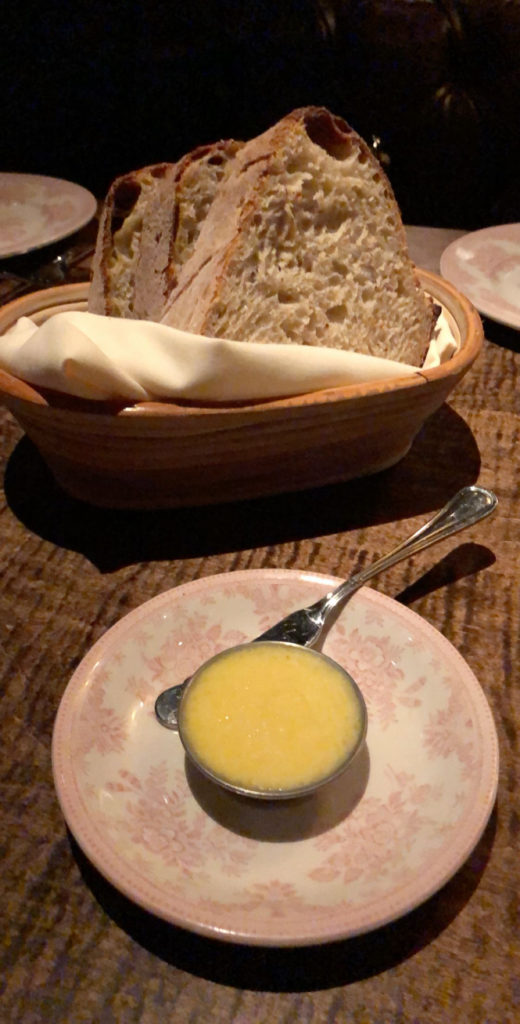
In short order, the magnum is decanted (though not before the brokenbottom third of the cork is safely retrieved from the neck of the bottle). Yougreedily guide a taste down your gullet, roll it around the mouth, aerate,slurp, and eyes roll back in your head. “Wow, excellent, you’ll have to try ataste—Erik too.” The carafe is put aside, and then your bottle of Riesling ispoured. Von der Fels ’18, does life get any better? “Very nice.” You think youlike this bottle even more than the magnum—especially at one eighth of theprice—but, then again, you are a white wine drinker and might be singing adifferent tune by the time the steaks arrive.
It is ten minutes past the reservation time with no word where theother guests may be. Yet you know they departed the suburbs on time, and so itmust just be a matter of minutes until those last deluges of traffic aredefeated. That is ample time to get some food working, a familiar chilledseafood plateau you order so often that the kitchen knows to start shucking andshelling the moment your party sits down. While some dilletante food reviewershave steered their readers away from Bavette’s bounty of crustacean delights(in the interest of saving their money), there is truly no better place toorder king crab in the city. Over the course of dozens, perhaps more than fifty,visits to the restaurant, you remember two occasions where the crab was pulledfrom the menu due to the purveyor not meeting the kitchen’s standards. Think ofthat, a whole night’s revenue waived way in the interest of quality. You’vesurely had your share of watery, worthless crab at steakhouses that should knowbetter.
It is not just the king crab—deep red, plump, succulent, andsweet—that impresses. The oysters and shrimp punch well above the standard setaround the city while the lobster—at its core an overrated delicacy—is noslouch either. Bavette’s signature Maude’s Tower (Maude?—as in Maude’s LiquorBar (another Hogsalt property)?) includes two tiers toting all of these alongwith a coupe of salmon tartare. That tartare, truth be told, is the Achilles’heel of the entire plateau. You have even tried to build your own tower out ofindividual components to tiptoe around being served the tartare, and thekitchen has offered it gratis. The salmon surely is not terrible by anymeans. You’d be lying if you said you did not eat it all anyway. The texture isnice enough, but the flavor is simply a bit muted. Perhaps that is why it isserved with veritably excellent “everything” seasoned crackers that are quicklychomped down alongside the platter’s other offerings.
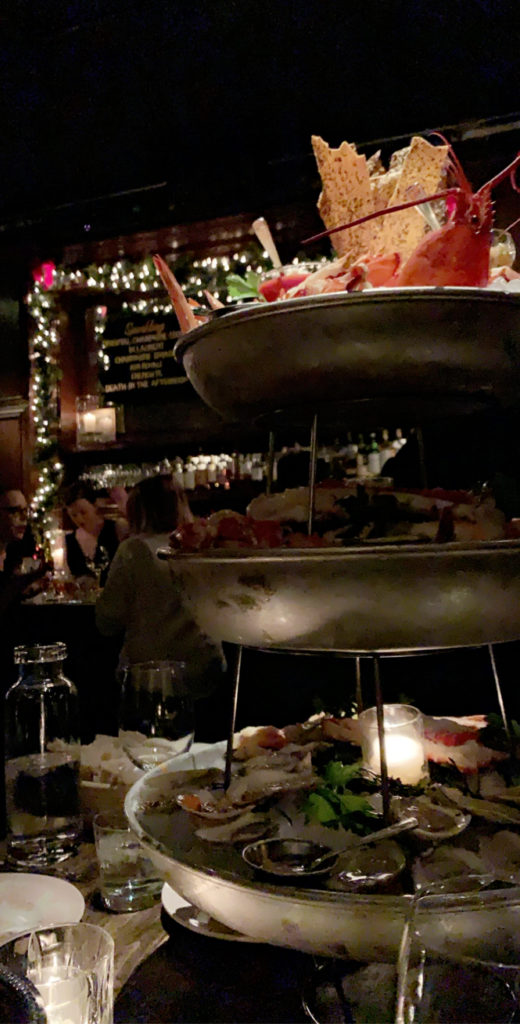
Anyway, you no longer bother trying to avoid that tartare. It is theone blemish on the work of beauty that prevents it from seeming too perfect,uncannily so. You corral the server and sing your usual tune: “one Maude’sTower with two extra pounds of king crab.” She’s a pro, and she’s handled youbefore, so there’s no exclamation of surprise. The extra allotment of crab (thetower comes with one sole pound) can vary by a half-pound or pound depending onthe size of the party, but two pounds is the standard amount to bring theplateau up to snuff. Never mind that you’re not sure you could ever really haveyour fill of crab this good. And with the Keller drinking sowell—suspiciously better than those bottles you sourced for your own cellar—youcould die a happy man after just the first course!
The fellows joining you arrive in short order and spy the tools liningthe table: cocktail forks, Crystal Hot Sauce, and metal bowls (to collect theshells). Hugs are exchanged, wine is poured (they, unlike you, prefer red butwill try a bit of Riesling knowing what’s to come), and—before you know it—thecavalry arrives. Two busboys greet the table with sheepish grins. They are theonly tie between the kitchen and the three of you who are about the devourtheir labor of love. The bottom level is put in place, anchoring the plateauwith an assortment of east and west coast oysters, shrimp, and some king crab.The middle layer—which, to your knowledge, is only ever dispatched for yourorder—is devoted solely to the additional crab. Lastly, the top piece houseslobster tails and claws, some more shrimp, and the aforementioned salmontartare with crackers. Drawn butter, mignonette, mayonnaise, and cocktail sauceare slid in front of you—it’s showtime!
The dust settles not ten minutes later. It must be said, the staff expertlyfacilitates the eating of the tower by removing the bottom layer upon itscompletion. This task requires at least two people but prevents you fromotherwise being unable to retrieve items from the top layer without blindlyreaching. The crab and oysters were as good as ever while the shrimp, perhapsjust a bit less plump than usual, still satisfied. Lobster and salmonmaintained the same usual quality, making for an admirable plateau overall.What comes next? Well, it’s hard to go wrong. The mid course between seafoodand steak at Bavette’s is open to the most variation from visit to visit. Thisis a testament both to the stalwart quality of the plateaux and steaks, as wellas the plethora of options offered outside of those categories.
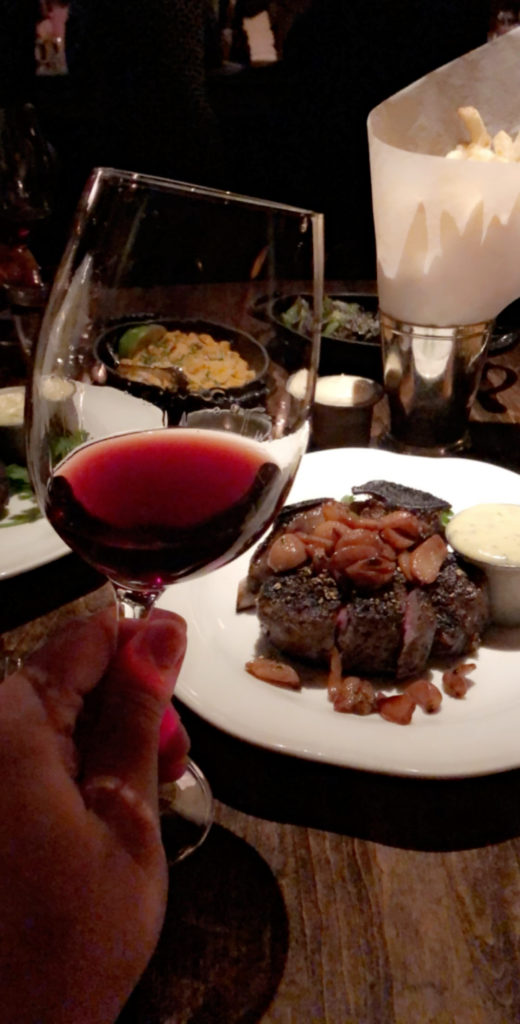
The restaurant’s wedge salad—a steakhouse classic—comes coated inranch (extra dressing on the side) with crumbled gorgonzola, egg, and onion.Warm, thick-cut bacon guilds the lily and makes for a most pleasing temperaturecontrast with the cold lettuce. Your party has also come to like Bavette’sLyonnaise salad: a classic assemblage of frisée lettuce, brioche croutons,soft-cooked egg and that same, superb thick-cut bacon. There are four othersalads on offer—all in whole or half sizes—that you have not yet tried but certainlywould not hesitate to do so given the steadfast quality of these two others.The salad course is also a particularly perfect time to enjoy the restaurant’ssourdough bread, which (though the restaurant is replete with claims to fame)ranks as the crispiest, crunchiest, and unquestionably best bread in thecity. Really, truly, it deserves that title—and do not be afraid to request theultra-crunchy “ends” of loaves be served to you too.
Still, it has been far too many weeks since your guests have dinedhere. Something more serious is in order. Perhaps the griddled cheeseburger, apremium offering from the same proprietors of Au Cheval’s coveted creation?Here, an 8 oz. patty sits topped with dijonnaise and sharp American cheese.Customers can top it with a farm fresh egg for $2 more, and, for $5 more, theburger can be crowned with that transcendent thick-cut bacon (which threatenseven to outdo the beef itself). The kitchen maintains a policy of not splittingits cheeseburger, but the front of house staff has always been more than happyto cut it into halves or quarters tableside—causing a slow ooze of egg yolkthat girds one’s loins all the more for the griddled delight before them. Thehand-cut fries, unsurprisingly, are absolutely unerring. Crispy, crunchy, andwell-salted, the fries’ only flaw is that they arrive without any ketchup (itspresence, however, may be requested).
But no, a burger will not do either—and those delicious fries canalways be added in with the steak order. Instead, Bavette’s spiced friedchicken seems suitable for the mid course. It is the only dish on the menu thatbears the restaurant’s name (and for good reason). The three pieces of breastthat come with an order sit stacked on top of each other (a parallel to yourthree-tiered plateau?) and nestled onto a mound of mashed potatoes. A boat ofsweet pea and cipollini gravy garnishes the other side of the plate. Thechicken’s breading boasts a golden brown crust with a captivating crunch andmildly piquant taste that, nonetheless, allows the profound juiciness of thebird to shine. The mashed potatoes, it must be said, are rather nice too.Sticky and ever so slightly chunky, they stick to your ribs in the mostpleasant of ways and only benefit (like the chicken itself) from a healthy pourof the gravy.
Yes, the fried chicken will do quite nicely. Now what else? Oh, thereis a special this evening, something new. A lovely preparation of sablefishthat is marinated overnight in miso and simply sautéed. Bavette’s will reliablyoffer one or two specials an evening—sometimes in limited quantities—that arewell worth ordering. They show all the same finesse as the menu’s benchmarkitems, and this sablefish is no different. When it arrives at the tablealongside the chicken, the 2 x 2 strips of filleted fish (with a wedge of lemonon the side) look almost wimpy by comparison. Yet, once that citrus is squeezedand that sablefish reaches your tongue: nirvana! The flaky skin and moist fleshresonate perfectly with the deep umami of the miso. The dish can only be termed“deliciously simple,” and must rank among the healthiest but most pleasing fishofferings you’ve had on this or any menu in town.
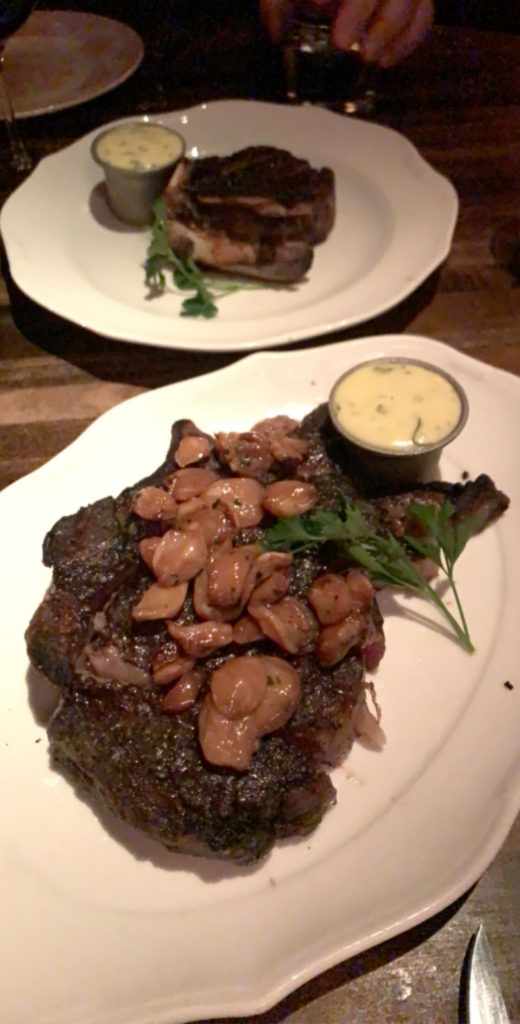
Finally, it is time for the main event, the reason that so many guestsmake their reservation a month in advance. Bavette’s beef is labelled USDAPrime and split into three familiar cuts. The filets come in 6 oz. and 10 oz.sizes along with a 16 oz. bone-in option. The ribeye is available either as a16 oz. classic “Chicago cut” or a 22 oz. bone-in size that is additionallydry-aged for a hefty 42 days. The New York strip comes in just one size: 16 oz.bone-in and also dry-aged for 42 days. That’s it. There’s no exorbitant JapaneseWagyu or Kobe at Bavette’s, no overpriced American wagyu or menu spaced devotedto touting various domestic ranches that nobody has ever heard of. Thedry-aging is kept simple and applied to certain cuts as deemed necessary. Thatis, the kitchen curates the steak selection rather than dumping outendless options of dubious quality like the city’s other steakhouses. Accompanimentsare varied and split into several price categories. $4 gets you peppercorncrust, maître d’butter, or roasted garlic while $7 conjures wild mushrooms orgorgonzola to go with your meat. Roasted bone marrow (at $8) and a warm kingcrab “Oscar” preparation costs $24 (though, having tried it once, you arecontent with the crab as it is in the plateau).
For you, the choice among these cuts is obvious (and has been sinceyour first visit). At a little over two inches thick, the bone-in filet is thebest piece of meat in town. It is always, and you mean always perfectlycooked, the thick, ruby-tinged slabs of beef turning into the equivalent of cowbutter when they slide onto the tongue. You rarely order filet mignon, but thisone cannot be missed. It stands as the ultimate testament to the cut, and,while you often enjoy it with the peppercorn crust added on, the topping’scrunch almost criminally subtracts from the supreme tenderness on offer. Youwould contrast this cut with the more petite pieces of filet on offer, but sosteadfast is the bone-in’s presence on your table that you cannot say you havetried—or even seen—them.
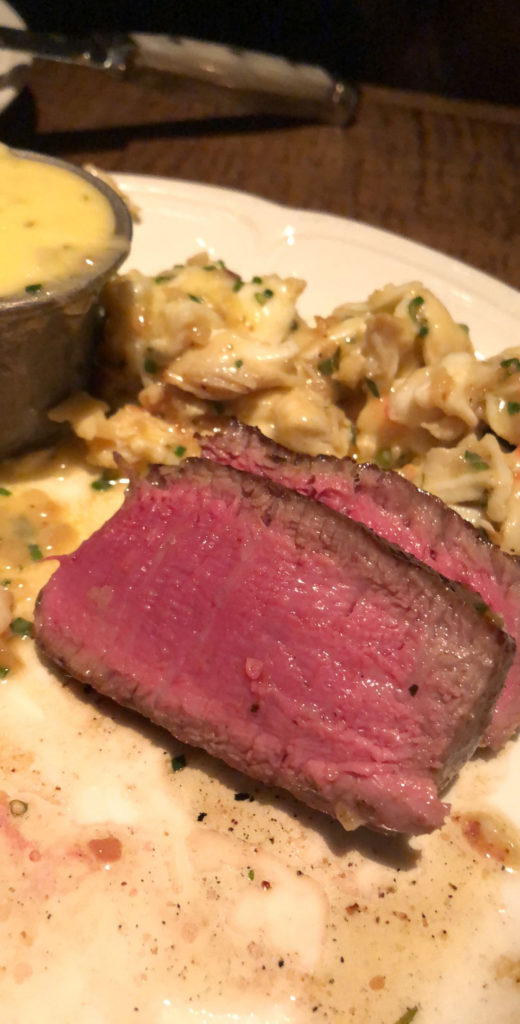
Next on the chopping block, the number two steak that more or lessalways accompanies that bone-in filet (unless, of course, you simply decide toorder several of those delightful cuts), is the bone-in, dry-aged ribeye. Whilethe lesser ribeye on the menu carries the name “Chicago cut,” you think thattitle is better applied to the bone-in variety. Sporting a healthy outer char(that, as it should be noted, all steaks at Bavette’s possess), the dry-agedribeye offers a deeper, “beefier” flavor than the filet with just a little morechew. You say “just a little,” as many of the city’s ribeyes—even those of theostentatious “Tomahawk” variety—come out a bit tough whether you order itmedium (some say this temperature dissolves the inner sinews of fat) or mediumrare. Tonight, cooked to medium temperature, the bone-in ribeye is a beautifulblushing pink. Juicy, with well-rendered caps of fat that dissolve in themouth, the steak possesses a sublime umami undercurrent by way of thedry-aging’s musky mushroom flavor. The roasted garlic accompaniment makes aperfect bedfellow to this piece of beef, and you never forget to pair the twotogether.
When hosting a larger party—or, perhaps, a particularly carnivoroussmaller group—you will sometimes trot out the bone-in, dry-aged New York strip.It’s a fine steak, one that would stand up against the vast majority in thecity, yet it suffers when compared to the two others previously mentioned. Thecut is thicker than the ribeye, coming much closer to the filet, but lacks theformer’s intensity of flavor and the latter’s incredible texture. You end upwith a cut that is somewhere in between the two without really exceling and“wowing” one’s palate. While the peppercorn crust can detract from the bone-infilet, you have no bones about applying it to this strip, where it works tomake the cut just a bit more interesting in comparison to the others on thetable. For most parties, you would recommend doubling up on the filet ratherthan add in a New York strip simply for variety’s sake.
The side dishes, in comparison to the steaks, are a whole ‘nother story.That is, you cannot go wrong with any one of the dozen dishes on offer. The pommesfrites (which also come with the cheeseburger) and the “buttery” mashedpotatoes (which coat the bottom of the fried chicken preparation) have alreadybeen praised. So has the thick-cut bacon, which is available as a showstoppingstandalone item.
The loaded baked potato—replete with bacon, sour cream, cheddarcheese, and chives—is deliciouslyoversized and impeccably dressed. One does not need to worry about eating chunksof unseasoned tuber as you work your way through the top layers. You cannot sayyou have tried the baked sweet potato—topped with butter and brown sugar—butthis is simply out of protest due to the restaurant removing a bourbon-glazed,candied sweet potato dish you deemed superior (if only by avoiding there beingtwo styles of baked potato on the menu). Oh, and there’s a “truffle” mac &cheese too. The “truffles,” you think must come from truffle oil given that noshavings appear in the dish. Nonetheless, its presence is not offensive andcertainly does not overshadow the creamy, molten white cheddar and al denteelbow noodles.
While the starchier offerings are just fine, you think it is thevegetables at Bavette’s that really shine. Both the creamed spinach—served witha molten mixture of blue cheese and caramelized onions—and the buttonmushrooms—covered in cream sherry with a coating of crispy onion strings ontop—bring an impressive amount of richness to proceedings. The dishes mightstrike some diners as a tad heavy, but they strike right at the essence oftheir respective ingredients, providing an ample mouthfeel and intensity offlavor to ensure that they are not wholly outshone by the steaks.
On the other hand, the charred broccoli, broiled asparagus, andbrussels sprouts sides are more simply prepared and textural. Rather thanmelting on the tongue along with the beef, these items retain their heartycrunch and draw on flavors like lemon or Dijon to revive the palate during thelatter portion of the meal. Tonight, a special offering of fresh Klug Farm peaswith roasted sweet onions and that always-wonderful bacon, fits into this samecategory. You only wish it wasn’t going out of season! Last amongst thesides—and striking somewhere in the middle of the two aforementionedcategories—is Bavette’s elote style corn. The kernels in this dish (which ranksas the only side item you must order each visit) retain a pleasing snapbut come dressed in a sauce of melted parmesan. Yet, rather than veer towardsbeing too rich, a hint of chili and squeeze of lime bring things back from thebrink. This elote style corn has it all, and it stands as a wonderful flourishthat breaks from the menu’s France-meets-Chicago theme.
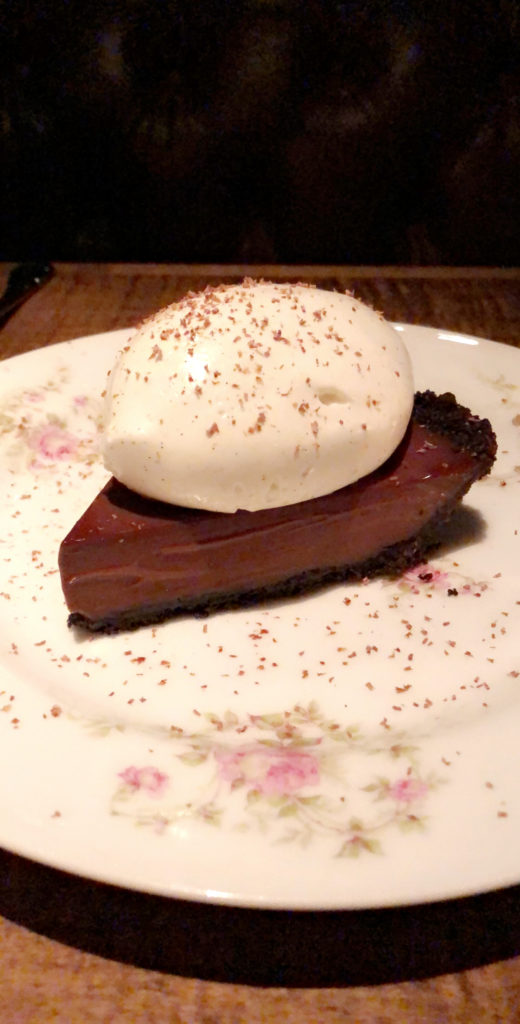
It comes as no surprise that Bavette’s dessert selection follows muchof the same formula as the rest of the menu: classics, done (very) well, withlittle extra ostentation or adornment. The chocolate cream pie boasts a fudgyfilling and crumbly crust along with a titanic dollop of whipped cream to offera reprieve from all the decadence. The lemon meringue pie, by contrast,possesses a torched mane of thick meringue taller than the pastry itself. It,again, plays well off of the filling (which, in this case, is quite pleasinglytart). The restaurant’s rendition of carrot cake is quite classic, with carrotssliver that are not too crunchy (but still clearly there) and a cream cheesefrosting that is fantastic (and why else does one order carrot cake?). Whileone person could take down a pie slice, you think the cake could (perhapsshould) easily be split by two. Last of all, the hot fudge sundae “royale” isthe real showstopper of the dessert menu. Customers are treated to three variedscoops of ice cream (two are always chocolate and vanilla) with whipped cream,cherry, hot fudge, and dozen assorted toppings that include cookies, brownies,candy bars, marshmallows, and more. You marvel at the restaurant’s ability torepackage and charge a premium for slivers of Kit Kats and Reese’s Cups, butthere’s no denying the ice cream is damn good.
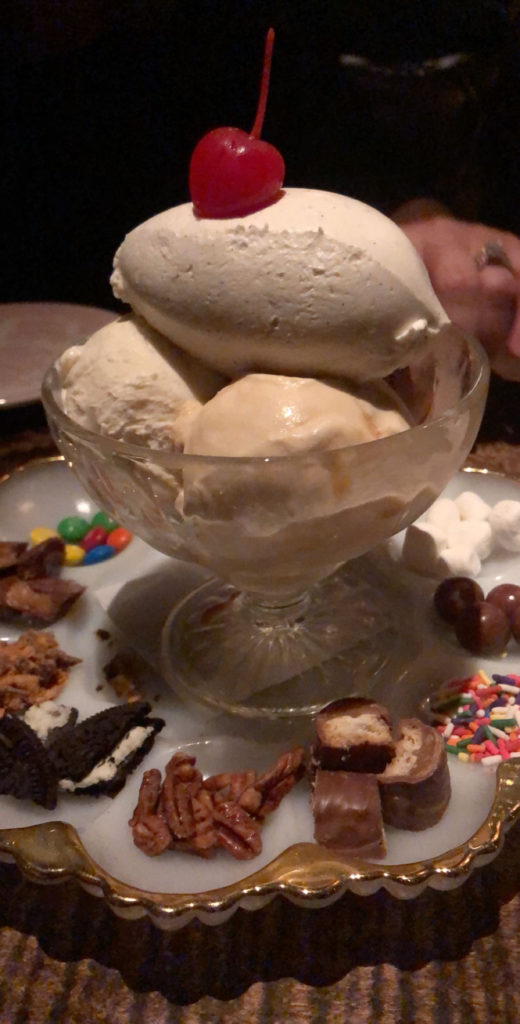
Alas, you skip dessert this evening having so enjoyed your wines, yourseafood plateau, the fried chicken, the sablefish, and your selection of steaksand sides. It has been another unforgettable meal at Bavette’s, an experienceso well-curated, so unblemished time after time that perfection becomes anexpectation. The pacing was perfect: each of the three courses enteredindividually with ample pauses in between (and no sort of prodding so that theservers may turn the table). Neither water nor wine glasses were ever leftempty, due to some of the best bussers in the business. And the server, too,knew to have your steaks arrive sliced even though you forgot to ask for itwhen reciting the breadth of your order.
Bavette’s is a restaurant where no little detail goes neglected, butyou, the diner, never for an instant feel fussed over. Not every party willpartake in the same bacchanalia that your table did, and there is no need to“play that game” to ensure proper service. The staff shows the same warmthwhether you order cocktail or Cabernet, burger or bone-in filet. Theestablishment is totally at peace with itself. The food? Confident in itssimplicity. The staff? Content and expressive. There is something eternal aboutBavette’s. Something that feels like you truly are stepping into another world,another time. It is the standard-bearer for the “Chicago steakhouse” and thevery first place I would recommend to any friend with more traditional tastes.
In the city’s most crowded genre of restaurant, Bavette’s excels by offering “less,” not “MORE,” ditching any sort of “corporate” feel, and never compromising on quality (without needing to shove it in your face). It sets a benchmark that you would pit against any steakhouse—perhaps any American restaurant—in the country.


